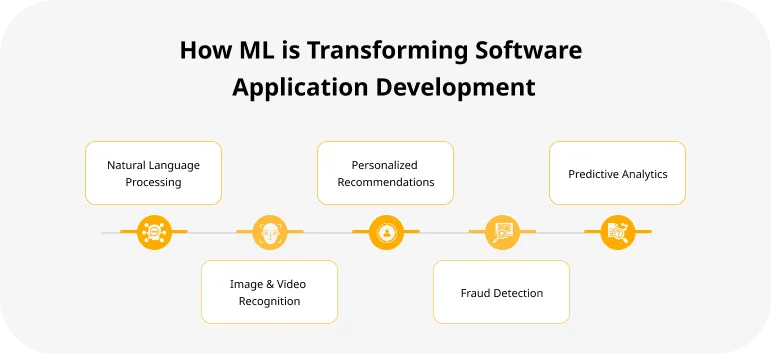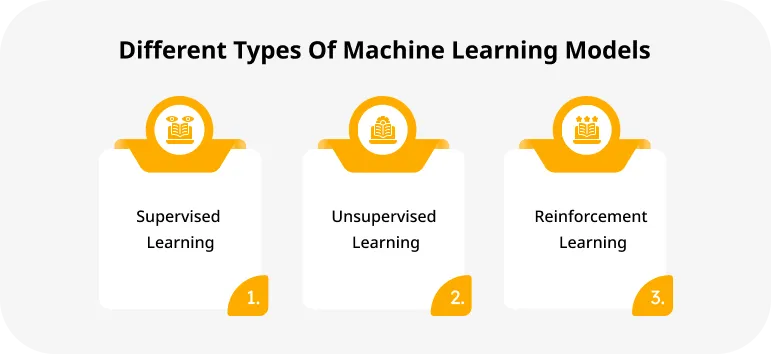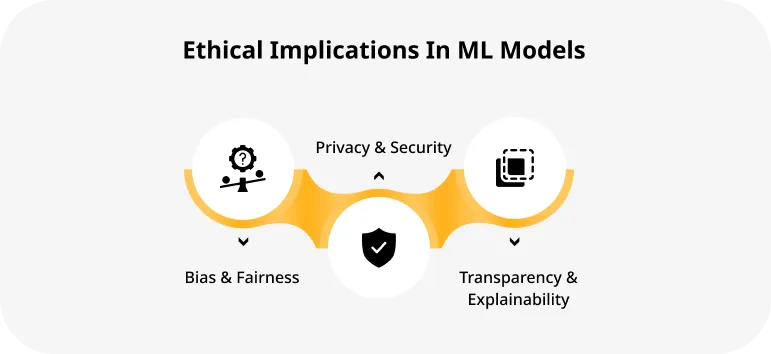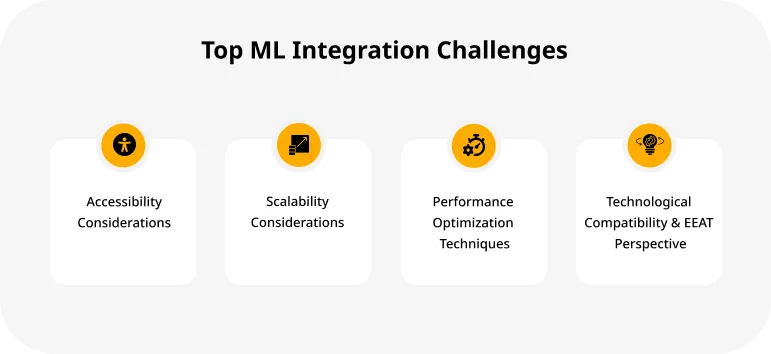Have you ever imagined the fusion of machine learning models with software apps?
Yes, this fusion has opened up a realm of endless possibilities.
Integrating machine learning models into software applications brings forth many opportunities & challenges, touching upon ethical considerations, environmental impact, accessibility, and technological advancements.
As you delve into ML model integration, it is crucial to navigate these aspects with care & foresight. This blog post will provide the best practices that will empower developers & organizations to harness the full potential of machine learning models.
Join us on this journey as we uncover the key considerations and strategies for successfully integrating machine learning models for software applications.
Recent Trends in How ML is Transforming Software Applications
Machine learning has been revolutionizing the software application development industry in various ways.
Here are a few recent examples:
Natural Language Processing
ML-powered NLP techniques have significantly improved applications as
- Chatbots
- Virtual assistants
- Language translation tools
These applications can now understand and generate human-like text. It also enables more effective communication between humans & machines.
Image & Video Recognition
ML algorithms have made remarkable progress in image and video recognition tasks. Applications that rely on ML models to analyze visual data & make accurate predictions are.
- Facial recognition
- Object detection
- Autonomous vehicles
Personalized Recommendations
ML algorithms are widely used to provide personalized recommendations in various domains, such as:
- eCommerce
- Streaming platforms
- Social media
ML models can suggest relevant products, movies, or content tailored to individual users by analyzing user behavior and preferences.
Fraud Detection
ML techniques have greatly enhanced fraud detection systems in finance & cybersecurity. ML models can:
- Analyze large volumes of data
- Identify patterns
- Detect anomalies
It further helps to prevent fraudulent activities and protect sensitive information.
Predictive Analytics
Machine learning models enable software applications to make predictions based on historical data. This is particularly useful in areas like:
- Sales forecasting
- Demand prediction
- Predictive maintenance
Machine learning in predictive analytics analyzes patterns & trends to provide valuable insights for decision-making.
Our experts are ready to assist
Moreover, developers can create more intelligent, efficient, and user-friendly software systems by leveraging the power of machine learning.
Understanding Machine Learning Models
Machine learning models have become powerful tools for developing intelligent software applications with ML. However, selecting the right machine learning model is critical in integrating machine learning into software applications.
By understanding the different types of models and considering the associated ethical implications, you can build applications that are not only effective but also responsible and trustworthy.
Types of Machine Learning Models
Supervised Learning
Supervised learning involves training a model using labeled data, where the desired output is known. This type of model is commonly used for tasks like classification and regression.
Ethical implications may arise when dealing with sensitive data or biased training sets, leading to potential discrimination or privacy concerns.
Unsupervised Learning
Unsupervised learning focuses on finding patterns and relationships in unlabeled data. Clustering and dimensionality reduction are common applications of unsupervised learning.
Ethical considerations in this context revolve around data privacy and the potential unintended consequences of unsupervised algorithms.
Also Read: Artificial Intelligence Vs. Machine Learning Vs. Deep Learning: New Ethics Of Future Advancement!
Reinforcement Learning
Reinforcement learning involves training an agent to interact with an environment and learn from feedback in the form of rewards or penalties. This type of model is often used in robotics and game-playing.
Ethical implications arise when defining reward structures that align with desired behaviors and avoiding negative consequences or unintended actions.
Ethical Considerations in Model Selection
When selecting machine learning models, it is essential to consider the following ethical implications:
Bias & Fairness
Models trained on biased data can perpetuate and amplify existing societal biases. It is crucial to address bias during data collection, preprocessing, and model training to ensure fairness & avoid discrimination.
Privacy & Security
Machine learning models often deal with sensitive user data. Hence, it is essential to implement robust security measures to protect user privacy & prevent unauthorized access or misuse of data.
Transparency & Explainability
As machine learning models become complex, it is essential to ensure transparency and explainability. Users should have a clear understanding of how the model makes decisions and be able to trust its outputs.
Tap into our deep tech expertise
Preparing Your Data
When integrating machine learning models into software applications, it becomes crucial to prioritize ethical considerations in data collection & handling.
- Ethical data practices ensure that the data used for training and testing models is obtained in a responsible & unbiased manner.
One important aspect to emphasize is the significance of data quality. High-quality data is required for building accurate & reliable machine-learning models.
- It is crucial to ensure that the data is relevant, up-to-date, and representative of the problem you are trying to solve.
Another critical consideration is addressing biases in the data. Biases can arise due to various factors, such as the data collection process or inherent societal biases. It is essential to be aware of these biases and take steps to mitigate them.
- This involves carefully selecting diverse and representative datasets and implementing techniques like data augmentation and balancing to address data imbalances.
Data preprocessing and feature engineering are critical to preparing your data or info.
- Preprocessing involves cleaning & transforming the data to make it suitable for training the machine learning models.
- Feature engineering focuses on selecting and creating relevant features that capture the essential aspects of the problem.
Both of these steps improve the performance and generalizability of the models.
By emphasizing the importance of ethical data collection and handling, discussing data quality and biases, and following best practices for data preprocessing and feature engineering, you can ensure that your ML models are built on a solid foundation and must integrate machine learning models effectively into software applications.
Also Read – Winning With AI and Machine Learning Frameworks
Building & Training ML Models
Choosing the right tools and libraries is crucial when developing machine learning models. There are various machine learning frameworks available, such as
- TensorFlow
- PyTorch
- Scikit-learn
Each of the above frameworks comes with its strengths and weaknesses. Hence, it is important to consider the following factors:
- Ease of use
- Community support
- Compatibility with your specific requirements
Once you have selected the appropriate tools, hyperparameter tuning, and cross-validation techniques are vital in optimizing your ML models.
- Hyperparameters are parameters not learned from the data but set before training. Tuning these hyperparameters can significantly impact the performance of your models.
- Cross-validation helps assess your models’ generalization ability by splitting the data into multiple subsets for training and evaluation.
Do it with expert guidance and practical solutions.
While developing ML models, always keep ethical considerations in mind.
For the decision-making process, it is crucial to ensure
- Fairness
- Transparency
- Accountability
Bias in data or algorithms can lead to discriminatory outcomes, so it is important to address these issues and strive for fairness and inclusivity.
Another aspect to consider is the environmental impact of training large ML models. Training these models requires substantial computational resources, which can consume significant energy.
To mitigate this impact, researchers and practitioners are exploring techniques like model compression, knowledge distillation, and using renewable energy sources for training.
Integration Challenges
ML application development effectively incorporates ML models while considering accessibility, scalability, performance, and technological compatibility by addressing these integration challenges with effective ML integration strategies.
Accessibility Considerations
When integrating machine learning models into software applications, it becomes crucial to consider accessibility for all users. This involves ensuring that the ML models and their outputs are accessible to individuals with disabilities.
For example, providing alternative text for visual outputs or using voice-based interfaces for users with limited mobility.
Scalability Considerations
As ML models become more complex and datasets grow, scalability becomes a significant challenge. It is important to design systems that handle increasing user loads and process larger datasets efficiently. This involves:
- Optimizing algorithms
- Utilizing distributed computing
- Leveraging cloud-based solutions
Performance Optimization Techniques
Real-time predictions are often required in software applications that integrate ML models. To achieve optimal performance, various techniques can be employed.
This includes the following to reduce latency
- Optimizing code
- Utilizing hardware accelerators like GPUs
- Implementing caching mechanisms
Technological Compatibility & EEAT Perspective
Ensuring technological compatibility with existing systems is crucial from an ethical, environmental, accessibility, and trustworthiness (EEAT) perspective. Compatibility ensures:
- Seamless integration with legacy systems
- Reduces potential disruptions
- Maintains data integrity and security
Also Read: Why Is Machine Learning The Best For Fraud Prevention
Model Deployment & Monitoring
Model deployment refers to making a trained machine-learning model available in a production environment. It involves taking the model from a development or testing phase & integrating it into a software application or system.
Technological Aspects of Deploying & Monitoring ML Models:
When deploying ML models, several technical aspects need to be considered. This includes
- Selecting the appropriate infrastructure, such as cloud platforms or on-premises servers, to host the model.
- Setting up the necessary software dependencies & ensuring compatibility with the target environment.
Monitoring ML models is crucial to ensure their performance and reliability. This involves
tracking the following metrics to identify any issues or anomalies.
- Accuracy
- Latency
- Resource utilization
Monitoring can be done through logging, alerting, and visualization tools, which provide insights into the model’s behavior and help make informed decisions for improvements or troubleshooting.
Accessibility & Usability Considerations
Deploying ML models for diverse user groups requires careful consideration of accessibility and usability.
- Accessibility involves ensuring that the deployed models can be accessed and used by users with different devices, operating systems, or assistive technologies.
- Usability considerations involve designing user interfaces that are intuitive, user-friendly and provide clear instructions on interacting with the models.
By addressing these technological aspects and considering accessibility and usability, developers can effectively integrate machine learning models into software applications, providing valuable functionality to end-users.
Ethical & Regulatory Considerations
When integrating machine learning models into software applications, it is crucial to address the ethical & regulatory considerations surrounding data storage and processing.
Environmental impact
Data storage and processing can consume significant energy, contributing to carbon emissions and environmental degradation. To mitigate this impact, organizations should:
- Prioritize the use of energy-efficient infrastructure
- Explore sustainable data storage options
Regulations
These regulations aim to prevent discrimination and promote inclusivity. When integrating machine learning models, it is essential to consider the accessibility requirements outlined in these regulations. This includes:
- Providing alternative formats for individuals with visual impairments
- Ensuring compatibility with assistive technologies
- Adhering to web accessibility guidelines
By proactively addressing these ethical & regulatory considerations, organizations usually demonstrate their commitment to responsible and inclusive machine learning integration tips, fostering trust among users and stakeholders.
Leverage our 19+ years of tech leadership.
User Experience & Feedback Loop
Integrating machine learning models of software applications offers immense potential for enhancing the user experience.
ML models analyze vast amounts of data and provide users with personalized recommendations, predictions, and insights. By leveraging ML algorithms, software applications can adapt and learn from user interactions, continuously improving the user experience.
The feedback loop plays a critical role in this process. Developers can refine and optimize the application’s performance by collecting user feedback and incorporating it into the ML models.
This iterative feedback loop allows for continuous improvement, ensuring the ML models provide accurate and relevant results, ultimately enhancing the overall user experience.
Importance of Considering Accessibility in User Interface Design:
When integrating ML models into software applications, it is essential to consider accessibility. Accessibility in UI design ensures that individuals with disabilities can access & use the application effectively.
ML models contribute to accessibility by providing features such as
- Voice recognition
- Natural language processing
- Image recognition
It enables users with disabilities to interact with the application seamlessly.
By incorporating accessibility features into the user interface design, developers can create inclusive software applications catering to diverse users.
This not only improves the user experience for individuals with disabilities but also enhances the overall usability and satisfaction for all users.
Ethical Considerations to Improve User Trust and Satisfaction:
Ethical considerations play a vital role in integrating ML models into software applications. Users expect their data to be handled responsibly and ethically. It is crucial for developers to prioritize the following things while implementing machine learning models:
- User privacy
- Data security
- Transparency
You can hire machine learning experts who build trust with users by adopting ethical practices, such as obtaining informed consent, anonymizing data, and providing clear explanations of how ML models are used.
This trust fosters user satisfaction and loyalty. Hence, it will ultimately create a positive user experience.
Conclusion
So far, we have seen that integrating machine learning models into software applications requires careful consideration & adherence to best practices.
From selecting the suitable model and preprocessing the data to monitoring & updating the model, each step plays a crucial role in achieving optimal performance & user satisfaction.
With the rapid advancements in machine learning development, businesses need to stay updated with the latest techniques & tools to leverage the full potential of these models.
By embracing these best practices, our experts at ValueCoders harness the power of machine learning models & deliver innovative machine-learning solutions that enhance user experiences and drive business growth.
ValueCoders is a leading AI Services Company providing software product development services since 2004 and has successfully delivered 4200+ projects till date.














